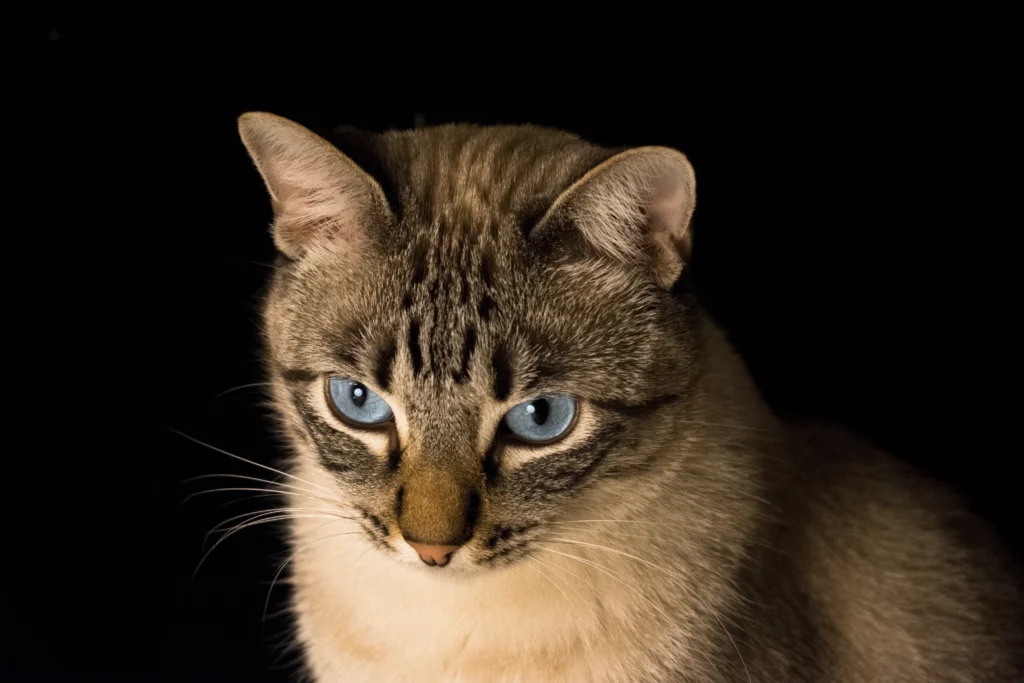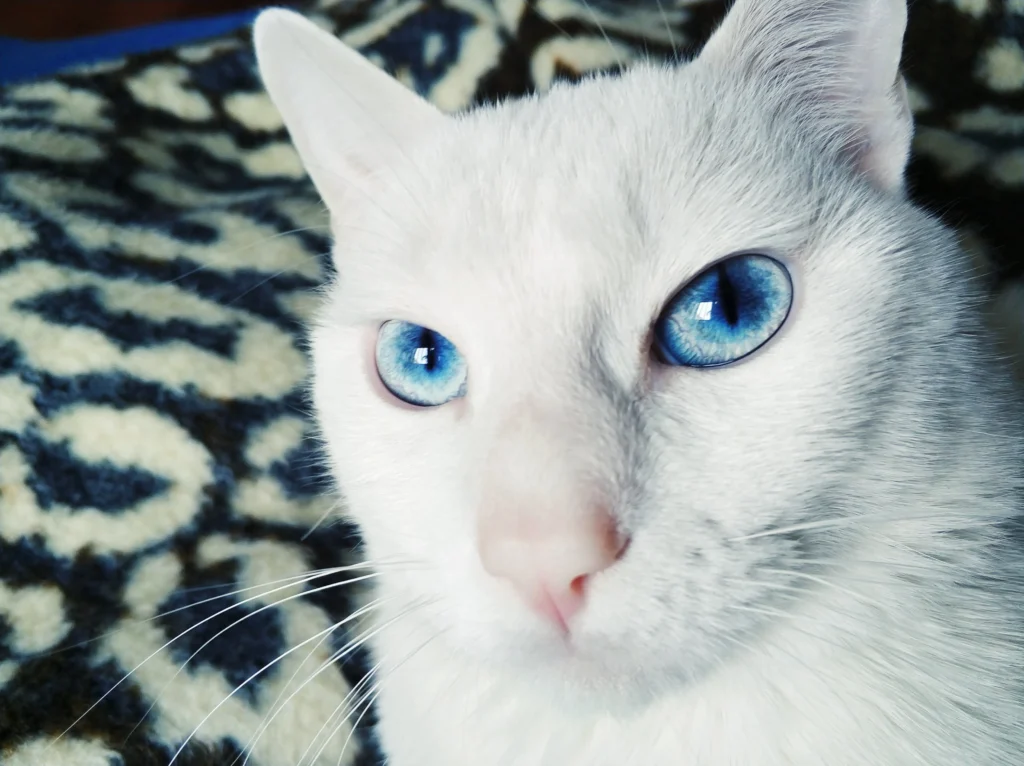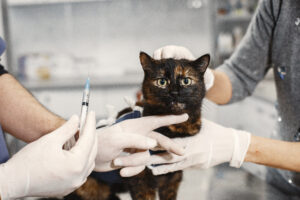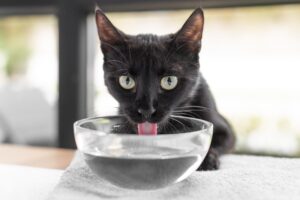Introduction
Blue eyes in cats are not just a stunning feature that captures our attention—they’re also relatively rare in the feline world. Most adult cats have eye colors ranging from golden to green, making cat breeds with blue eyes especially sought after by cat enthusiasts. If you’ve ever been mesmerized by a feline’s sapphire gaze, you’re not alone. The allure of cats with striking blue eyes has fascinated humans for centuries.
The genetics behind blue eyes in cats is fascinating. Unlike most eye colors in cats, which result from melanin pigmentation, blue-eyed cat breeds have eyes that appear blue due to the way light reflects off the eye structure—similar to why the sky appears blue. This unique characteristic is found in several cat breeds, each with its own distinctive traits beyond just eye color.
In this comprehensive guide, we’ll explore the most captivating cat breeds with blue eyes, discuss what makes these azure-eyed felines special, and provide essential care information for these remarkable companions. Whether you’re considering adopting a blue-eyed beauty or simply appreciate their unique charm, this article covers everything you need to know about these extraordinary cat breeds with bright blue eyes.

Why Some Cats Have Blue Eyes
Before diving into specific breeds, let’s understand why do some cats have blue eyes. This striking feature occurs through several genetic mechanisms:
The Science Behind Blue Eyes in Cats
Blue eyes in cats result from either a lack of melanin in the iris or the particular way light scatters in the eye structure. There are actually several different genetic factors that can result in cats with turquoise eyes or deeper blue hues:
- The White Masking Gene: Cats with the dominant white gene (W) often have blue eyes. This gene essentially “masks” the cat’s actual color pattern and can affect eye pigmentation.
- Point Coloration: In breeds with point coloration, like the Siamese, the temperature-sensitive albinism causes reduced melanin production in cooler body areas, including the eyes.
- White Spotting Gene: Cats with high degrees of white spotting (particularly those with white faces) may have one or both blue eyes.
- Ojos Azules Gene: A rare gene found in the Ojos Azules breed creates blue eyes without connection to coat color.
Interestingly, all kittens are born with blue eyes regardless of what their adult eye color will eventually be. Most blue-eyed kittens will see their eye color change between 4-10 weeks of age as their permanent eye color develops. When adult cats maintain blue eyes, it’s typically due to one of the genetic factors mentioned above.
Are Blue Eyes in Cats Associated with Health Concerns?
A common question about cat breeds with blue eyes is whether this trait is associated with health problems. While blue eyes themselves aren’t inherently problematic, certain genetic combinations can indeed present issues:
- Congenital Deafness: White cats with blue eyes have approximately a 40% chance of being deaf. If a white cat has one blue eye and one eye of another color (a condition called heterochromia), they may be deaf only on the side with the blue eye.
- Vision Issues: Some blue-eyed cat breeds with certain genetic mutations may have higher rates of progressive retinal atrophy or other vision problems.
It’s important to note that not all cat breeds with blue eyes have health concerns. Many purebred lines have been carefully developed to minimize these risks, and reputable breeders test their breeding stock for genetic issues.
Most Popular Cat Breeds with Blue Eyes

Let’s explore the most captivating cat breeds with blue eyes that cat lovers around the world adore:
1. Siamese Cats: The Classic Blue-Eyed Beauty
When most people think of cat breeds with blue eyes, the Siamese immediately comes to mind. This ancient breed from Thailand (formerly Siam) is perhaps the most recognizable blue-eyed cat species in the world.
Distinguishing Features of the Siamese Cat with Blue Eyes
The Siamese cat with blue eyes is known for several distinctive characteristics:
- Striking Blue Eyes: Siamese cats have arguably the most vivid, deep blue eyes of any cat breed. Their eyes appear almost luminous against their color-pointed coats.
- Point Coloration: Siamese cats have darker fur on their ears, face, paws, and tail (the “points”), with a lighter body color. This temperature-sensitive coloration is directly related to the same genetic feature that gives them blue eyes.
- Body Type: Modern Siamese cats have a sleek, elongated body with a triangular head and large ears, while traditional (or “Thai”) Siamese have a more moderate, rounded appearance.
- Personality: Siamese cats are extraordinarily vocal, intelligent, and social. They form strong bonds with their humans and are known for their “dog-like” tendencies to follow their owners around.
The connection between the Siamese’s blue eyes and their point coloration comes from a form of partial albinism. The temperature-sensitive enzyme responsible for producing melanin (color) functions only in the cooler parts of the body—the extremities—resulting in both the darker points and the blue eyes.
Siamese Color Variations
While all Siamese cats have blue eyes, they come in several color variations:
- Seal Point: The original and most common Siamese coloration, with dark brown, almost black points
- Blue Point: Slate-gray colored points
- Chocolate Point: Milk-chocolate colored points
- Lilac Point: Pale, frosty gray points with a pinkish tone
- Red (Flame) Point: Orangey-red points
- Cream Point: Creamy off-white points
- Lynx Point: Any of the above colors but with tabby striping in the points
All these variations maintain the signature sapphire blue eyes that make Siamese cat with blue eyes so distinctive and beloved.
Care Considerations for Siamese Cats
If you’re considering adding a Siamese to your family, here are some care tips:
- Mental Stimulation: These highly intelligent cats need plenty of interactive play and puzzle toys to keep their minds engaged.
- Social Interaction: Siamese cats do not do well when left alone for long periods. Consider getting a pair or ensuring someone is home regularly.
- Grooming: Their short coat requires minimal grooming—weekly brushing is usually sufficient.
- Health Monitoring: Siamese can be prone to certain genetic conditions, including progressive retinal atrophy, heart problems, and respiratory issues.
2. Ragdoll: Gentle Giants with Sapphire Eyes

Ragdolls are another stunning example of cat breeds with blue eyes that have captured the hearts of cat enthusiasts worldwide. These gentle giants are named for their tendency to go limp like a ragdoll when picked up—a unique trait that complements their striking appearance.
Distinguishing Features of Ragdolls
The Ragdoll stands out among blue-eyed cat breeds for several reasons:
- Brilliant Blue Eyes: Ragdolls have large, oval eyes in a stunning sapphire blue color that seems to capture light beautifully.
- Semi-Longhaired Coat: They have a plush, silky coat that’s longer around the ruff, tail, and britches with minimal undercoat, making them less prone to matting than other longhaired breeds.
- Color Point Pattern: Like Siamese, Ragdolls are color pointed, but they also come in additional patterns such as bicolor and mitted varieties.
- Impressive Size: Ragdolls are among the largest domestic cat breeds, with males weighing 15-20 pounds and females 10-15 pounds when fully grown.
- Docile Temperament: They’re known for their relaxed, affectionate nature and tend to be exceptionally tolerant, making them excellent family pets.
Ragdoll Color and Pattern Variations
All Ragdolls have blue eyes, but they come in various colors and patterns:
Colors:
- Seal
- Blue
- Chocolate
- Lilac
- Red
- Cream
- Tortie
Patterns:
- Colorpoint: Similar to Siamese, with light bodies and colored extremities
- Mitted: Color points with white “mittens” on the paws and often a white chin and belly stripe
- Bicolor: Color points with inverted “V” white marking on the face, white legs, white chest, and white belly
The combination of these colors and patterns, always accompanied by those mesmerizing blue eyes, gives Ragdoll enthusiasts a wide variety of looks to appreciate within the breed.
Care Considerations for Ragdolls
If you’re considering bringing a Ragdoll into your home, keep these care tips in mind:
- Grooming: Despite their long coat, Ragdolls require relatively moderate grooming—brushing twice weekly is usually sufficient due to their minimal undercoat.
- Indoor Living: Ragdolls should be kept as indoor cats due to their trusting nature and lack of strong defensive instincts.
- Space Needs: These large cats appreciate having room to stretch out, though they’re not particularly high-energy.
- Health Monitoring: Ragdolls can be predisposed to hypertrophic cardiomyopathy (HCM), polycystic kidney disease, and bladder stones.
3. Balinese: The Longhaired Siamese with Azure Eyes
The Balinese cat represents another exquisite example of cat breeds with blue eyes. Often described as the longhaired version of the Siamese, these cats combine the striking blue eyes and point coloration of their short-haired cousins with a graceful, medium-length silky coat.
Distinguishing Features of the Balinese
The Balinese stands out among cat breeds with vivid blue eyes for several characteristics:
- Brilliant Blue Eyes: Like their Siamese relatives, Balinese cats have intense blue eyes that contrast beautifully with their pointed coloration.
- Medium-Length Coat: Unlike the short coat of the Siamese, Balinese cats have a silky, flowing medium-length coat that forms a plume on the tail.
- Elegant Body Structure: They have the same svelte, muscular body type as the Siamese, with long lines and graceful movements.
- Personality: Balinese cats share the Siamese’s intelligence and vocalization tendencies but are often described as slightly softer in personality—still social and interactive, but perhaps a touch less demanding.
The name “Balinese” comes not from their origin (they were developed in the United States) but because their graceful movements and flowing coat reminded breeders of Balinese dancers.
Balinese Color Variations
Like the Siamese, Balinese cats come in various point colors, all featuring those signature blue eyes:
- Seal point
- Blue point
- Chocolate point
- Lilac point
- Red point
- Cream point
- Various lynx (tabby) and tortie point combinations
It’s worth noting that the Javanese cat (sometimes considered a color variation of the Balinese) expands this palette even further.
Care Considerations for Balinese Cats

If you’re considering a Balinese as your blue-eyed companion:
- Grooming: Despite their longer coat, Balinese cats don’t have a thick undercoat, so they require less grooming than many longhaired breeds. Weekly brushing is typically sufficient.
- Mental Stimulation: Like their Siamese cousins, Balinese are intelligent cats that need plenty of interactive play and stimulation.
- Companionship: These social cats don’t like being left alone for long periods. Consider getting a pair or ensuring someone is home regularly.
- Health Monitoring: They can be prone to some of the same conditions as Siamese, including progressive retinal atrophy and respiratory issues.
4. Persian: Aristocratic Felines with Sky-Blue Gaze
While not all Persians have blue eyes, certain color varieties of this ancient breed display some of the most beautiful blue eyes in the feline world. Blue-eyed Persian cats typically have white or color-pointed coats, and their eyes range from deep sapphire to pale sky blue.
Distinguishing Features of Blue-Eyed Persians
Persian cats with blue eyes stand out among cat breeds with blue eyes and white fur for several distinctive traits:
- Luxurious Coat: Persians have an extraordinarily thick, long, and plush double coat that requires significant grooming attention.
- Distinctive Face: Traditional Persians have a “doll face” with a short muzzle, while show Persians have an extreme facial structure with a flatter face (brachycephalic).
- Sturdy, Cobby Body: Unlike the sleek Siamese and Balinese, Persians have a stocky, low-set body with short, thick legs and a broad chest.
- Sweet Temperament: Persians are known for their gentle, quiet demeanor. They tend to be less active than many breeds, preferring to decorate the home with their regal presence rather than racing through it.
The Himalayan Persian (also called Himalayan or “Himmie”) is technically a sub-breed of Persian with Siamese-style point coloration and consistently blue eyes. These cats combine Persian features with the color pattern and blue eyes associated with the Siamese.
Persian Color Variations with Blue Eyes
Among Persians, these color varieties most commonly have blue eyes:
- Solid White: Pure white Persians often (but not always) have blue eyes. They may also have copper eyes or odd eyes (one blue, one copper).
- Himalayan/Colorpoint: All colorpoint Persians have blue eyes, similar to the Siamese, in colors including seal, blue, chocolate, lilac, cream, red, tortie, and various lynx (tabby) points.
- Bicolor: Some bicolor Persians with significant white on the face may have blue eyes.
Care Considerations for Blue-Eyed Persians
If you’re considering adding a blue-eyed Persian to your home:
- Intensive Grooming: Persians require daily combing to prevent matting of their dense double coat. Many owners opt for a “lion cut” during warmer months.
- Facial Hygiene: Flat-faced Persians need regular cleaning of facial folds to prevent skin infections, and regular eye cleaning to remove tear stains.
- Calm Environment: These cats prefer quiet, stable households with minimal disruptions.
- Health Monitoring: Persians can be prone to several health issues, including polycystic kidney disease, respiratory difficulties (especially in flat-faced varieties), and eye conditions.
Rare Cat Breeds with Blue Eyes
Beyond the more commonly known breeds, there are several rare cat breeds with blue eyes that deserve recognition for their unique beauty and characteristics.
Ojos Azules: The Blue-Eyed Wonder
Perhaps the rarest of all blue-eyed cat species is the Ojos Azules, a breed whose name literally means “blue eyes” in Spanish. What makes this breed remarkable is that they carry a unique dominant gene that produces deep blue eyes regardless of coat color—something not seen in other cat breeds.
Discovered in New Mexico in the 1980s, the Ojos Azules is extremely rare, with only a handful of confirmed cats in existence. The blue-eye gene in its homozygous form (when a cat inherits the gene from both parents) can cause cranial defects, so breeding must be done cautiously, contributing to the breed’s rarity.
Unlike the Siamese or other pointed breeds, an Ojos Azules can have a solid black coat and still display vivid blue eyes—a combination not found in other cat breeds with blue eyes.
Turkish Angora: White Beauties with Azure Eyes
The Turkish Angora is an ancient natural breed from Turkey, and while they come in many colors, the white Turkish Angora with blue eyes is particularly prized. These elegant cats have a silky, medium-length coat that requires surprisingly little maintenance despite its luxurious appearance.
What sets the blue-eyed white Turkish Angora apart from other cat breeds with blue eyes and white fur is their ancient lineage and natural development. These cats have been treasured in their native Turkey for centuries, where they were considered a national treasure.
Turkish Angoras may have blue eyes, amber eyes, green eyes, or odd eyes (heterochromia, with one blue eye and one eye of another color). Those with blue eyes showcase a particularly striking appearance with their snow-white coat and sapphire gaze.
Khao Manee: The “Diamond Eye” Cat from Thailand
Another extremely rare breed among cat breeds with bright blue eyes is the Khao Manee, also known as the “Diamond Eye” cat from Thailand. This ancient breed has been mentioned in the Tamra Maew (The Cat-Book Poems) from 14th-18th century Siam (Thailand).
The Khao Manee is always pure white and can have blue eyes, gold eyes, or odd eyes. Those with two blue eyes are particularly striking, while cats with one blue and one gold eye (heterochromia) were traditionally considered especially lucky in Thai culture.
This breed has only recently been recognized by major cat associations outside of Thailand and remains extremely rare worldwide, making it one of the most exclusive blue-eyed cat breeds available.
Mixed-Breed Cats with Blue Eyes
It’s important to acknowledge that many of the most beautiful cats with striking blue eyes are not purebred at all. Mixed-breed cats, particularly those with white coats or point coloration, can have stunning blue eyes that rival any pedigreed feline.
Domestic Shorthair and Longhair White Cats
White domestic cats, regardless of hair length, have a good chance of having blue eyes due to the white masking gene mentioned earlier. These cats may not have the consistency of a recognized breed, but many have strikingly beautiful blue eyes.
If you’re seeking a blue-eyed companion without the higher price tag of purebred cats with blue eyes, adopting a white cat from a shelter may be a perfect option. Just be aware of the potential connection between white coat, blue eyes, and deafness.
Pointed Mixed-Breeds
Mixed-breed cats with Siamese or Himalayan ancestry often inherit the point coloration pattern and accompanying blue eyes. These cats—sometimes affectionately called “Siamese mixes” or “Himalayan mixes”—can have all the beautiful blue-eyed charm of their purebred relatives with the unique character and often hardier constitution that comes with mixed genetics.
Caring for Blue-Eyed Cats: Special Considerations
While the care for cat breeds with blue eyes largely depends on their specific breed characteristics rather than eye color itself, there are a few special considerations for blue-eyed cats:
Sun Sensitivity
Many blue-eyed cats, especially those with white coats, may have increased sensitivity to bright sunlight. The lack of melanin that contributes to blue eye color can also mean less protection from UV rays. If your blue-eyed cat goes outdoors, consider limiting exposure during peak sunlight hours.
Vision Testing
Some (but not all) cat breeds with blue eyes have higher incidences of progressive retinal atrophy or other vision issues. Regular veterinary check-ups should include eye examinations to catch any potential issues early.
Hearing Tests for White Blue-Eyed Cats
If you have a white cat with one or both blue eyes, having a hearing test performed is advisable. While not all white blue-eyed cats are deaf, knowing about any hearing impairment allows you to make appropriate accommodations, such as:
- Avoiding startling a deaf cat by approaching from within their visual field
- Using visual cues rather than auditory ones for communication
- Keeping deaf cats indoors for safety
- Using vibration to get their attention when needed
General Care Based on Breed Characteristics
Beyond considerations related to eye color, care requirements will vary significantly depending on whether your blue-eyed cat is a short-haired Siamese, a fluffy Persian, or something in between. Consider:
- Grooming needs: From the minimal grooming of a Siamese to the daily brushing required for Persians
- Energy level: The playful athleticism of a Balinese versus the sedate nature of a Persian
- Social needs: The demanding interaction of Siamese-type breeds versus the more independent nature of some other breeds
The Appeal of Blue-Eyed Cats: Why We’re Captivated
What is it about cat breeds with blue eyes that so captivates human attention? Several factors contribute to our fascination:
Rarity and Distinctiveness
Blue eyes are relatively uncommon in adult cats, making them stand out. Our human brains are naturally drawn to things that are unusual or distinctive, and the brilliant blue gaze of certain cats certainly qualifies.
The Window to the Soul
Eyes are often described as “the window to the soul,” and the transparent, luminous quality of blue eyes seems to enhance this perception. The contrast between a blue iris and the black pupil creates a striking effect that many find particularly expressive.
Cultural Associations
In many cultures, blue has positive associations with clarity, tranquility, and depth (like the sky or ocean). These associations may unconsciously extend to our perception of blue-eyed cats.
Perceived Expressiveness
The high contrast between blue irises and pupils can make eye movements and pupil dilation more noticeable, potentially making blue-eyed cats appear more expressive or responsive to human interaction.
Choosing a Blue-Eyed Cat: Adoption Considerations
If you’ve fallen in love with cat breeds with blue eyes and are considering adding one to your family, here are some important considerations:
Breed-Specific Needs
Different blue-eyed cat breeds have vastly different care requirements, personalities, and health considerations. Research thoroughly to ensure the breed you’re interested in matches your lifestyle, living situation, and expectations.
Adoption Options
Consider these pathways to finding your blue-eyed companion:
- Breed-Specific Rescues: Organizations dedicated to specific breeds often have blue-eyed cats needing homes, particularly for more common breeds like Siamese and Persians.
- Reputable Breeders: If seeking a purebred, research breeders thoroughly, visit their facilities if possible, and verify they conduct appropriate health testing.
- Shelter Adoption: Many shelter cats, particularly white cats or pointed mixes, have beautiful blue eyes. Shelter staff can often help identify cats with specific characteristics you’re looking for.
Health Testing
When adopting from a breeder, ensure they provide appropriate health testing results for breed-specific concerns. For white blue-eyed cats especially, inquire about hearing testing.
Looking Beyond Eye Color
While blue eyes are undeniably beautiful, remember that your cat’s personality and how well it fits with your household are far more important factors for a successful human-feline relationship. Consider energy levels, sociability, grooming needs, and other factors alongside those mesmerizing blue eyes.
Conclusion
From the traditional Siamese cat with blue eyes to the rare Khao Manee, cat breeds with blue eyes offer a stunning variety of feline companions for those captivated by their azure gaze. Whether you’re drawn to the vocal personality of a Siamese, the gentle nature of a Ragdoll, the elegance of a Balinese, or the regal presence of a Persian, there’s a blue-eyed beauty that might be perfect for your home.
The allure of these most beautiful cat breeds with blue eyes isn’t just about aesthetics—each brings unique personality traits, care requirements, and characteristics that make them special beyond their eye color. Understanding these differences helps ensure that when those blue eyes gaze upon you from your new feline friend, they’ll belong to a cat that’s a perfect match for your lifestyle and preferences.
Whether you choose a purebred from a responsible breeder or discover a blue-eyed gem at your local shelter, these captivating cats offer the same love, companionship, and joy as their amber and green-eyed counterparts—just with an added dash of azure allure that’s been fascinating cat lovers for centuries.
FAQs About Cat Breeds with Blue Eyes
How rare are cats with blue eyes?
Blue eyes in adult cats are relatively uncommon, occurring primarily in cats with particular genetic traits like the white masking gene, colorpoint patterns, or specific breed-related genes. While all kittens have blue eyes initially, most change to their adult color by 12 weeks of age.
Do blue-eyed white cats have health problems?
White cats with blue eyes have approximately a 40% chance of congenital deafness. The genes responsible for white fur and blue eyes are associated with the development of the inner ear, which explains this connection. However, not all white blue-eyed cats are deaf, and deafness doesn’t prevent them from living full, happy lives.
Which cat breed is most likely to have blue eyes?
The Siamese and related breeds (Balinese, Himalayan, etc.) are most consistently blue-eyed, with virtually all cats of these breeds having blue eyes due to their colorpoint genetics. Other breeds like Ragdolls and Birmans also consistently have blue eyes.
Can cats with blue eyes see well?
In most cases, blue eye color doesn’t affect vision quality. However, some genetic combinations that produce blue eyes can be associated with certain vision issues in specific breeds. Regular veterinary eye exams are recommended for all cats, regardless of eye color.
Do male or female cats have blue eyes more often?
Eye color in cats is not sex-linked, meaning blue eyes occur with equal frequency in both male and female cats. The genetic factors that determine eye color operate independently of the genes that determine sex.
Can a cat’s eye color change from blue to another color?
All kittens are born with blue eyes, and most will see their eye color change between 4-10 weeks of age as melanin production in the iris increases. Once a cat reaches adulthood (around 1 year), their eye color is generally fixed and won’t change unless due to certain medical conditions.
Are there any completely black cats with blue eyes?
True black cats with blue eyes are extremely rare. The only breed known to potentially have this combination is the Ojos Azules, which carries a specific dominant gene for blue eyes regardless of coat color. In most other cases, blue eyes in black cats would likely indicate the cat is actually a very dark pointed breed rather than truly solid black.
References and Additional Resources
For more information about cat breeds with blue eyes and related topics, explore these reputable sources:
- The Cat Fanciers’ Association (CFA)
- The International Cat Association (TICA)
- Cornell University College of Veterinary Medicine – Feline Health Center
- PetMD – Cat Breeds
- PetsPump – Cat Breeds Guide
Whether you’re already sharing your home with a blue-eyed beauty or considering adding one to your family, understanding these remarkable cat breeds with blue eyes enhances appreciation for these special feline companions.
Note: This article is intended for informational purposes only. Always consult with a veterinarian for specific advice about your pet’s health and care.






